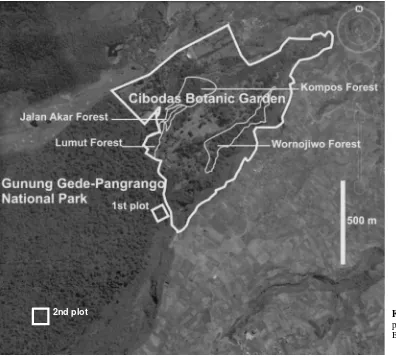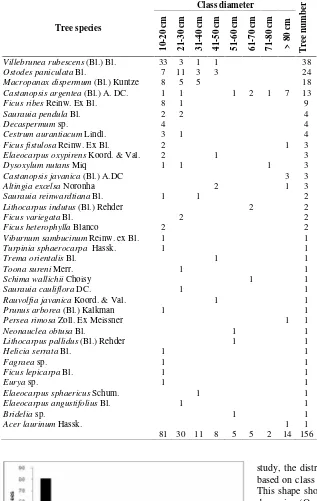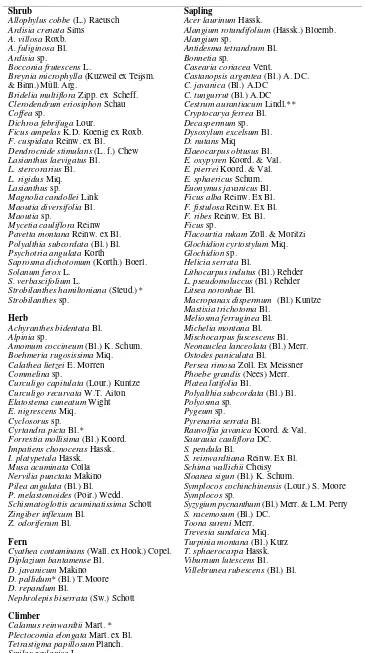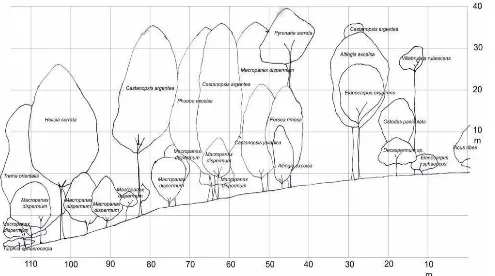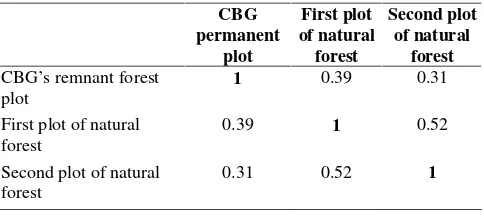Pages: 218-224 DOI: 10.13057/biodiv/d120406
Establishing a long-term permanent plot in remnant forest of Cibodas
Botanic Garden, West Java
ZAENAL MUTAQIEN♥, MUSYAROFAH ZUHRI♥♥
Cibodas Botanic Garden- Indonesian Institute of Sciences (LIPI), Sindanglaya, Cipanas, Cianjur 43253, West Java, Indonesia, Tel./Fax.: +62-263-512233, email:
zaenal.mutaqien@lipi.go.id,
ova_zuhri@yahoo.com Manuscript received: 4 December 2010. Revision accepted: 5 September 2011.
ABSTRACT
Mutaqien Z, Zuhri M (2011) Establishing a long-term permanent plot in remnant forest of Cibodas Botanic Garden, West Java. Biodiversitas 12: 218-224.Cibodas Botanic Garden (CBG) has unique characters; almost 10% of which is forested area adjacent to the natural forest of Mt. Gede Pangrango National Park. The area is a transition between natural forest and artificial habitat which mostly consists of exotic plant species. The permanent plot in CBG was established in 2007-2009. Two hundred and eighty four units of 10x10 square meters sub-plot were established in four locations, i.e. Wornojiwo, Kompos, Jalan Akar, and Lumut forest. Vegetation analyses were conducted for trees, saplings, shrubs, and herb species. The inventory found 137 species plants consisting of 74 tree species dominated byVillebrunea rubescens(Bl.) Bl. andOstodes paniculataBl., 30 shrub species dominated byStrobilanthes hamiltoniana (Steud.), 24 herb species dominated by Cyrtandra picta Bl., 6 fern species mainly consisted ofDiplazium pallidumMoore, and 3 climber species dominated byCalamus reinwardtiiMart.In comparison with the natural forest of Mt. Gede Pangrango National Park, the CBG permanent plot showed a good representative of the vegetation of lower montane forest. A regular monitoring during the successive years is needed to maintain diversity, monitor forest dynamics and anticipate the spread of invasive plant from CBG.
Key words:Cibodas Botanic Garden, permanent plots, remnant forest.
INTRODUCTION
Cibodas Botanic Garden (CBG) was used as an experi-mental plot for the introduction of Cinchona to Indonesia. When it was stated as a biological station and forest reserve, the area was extended up to 1,200 ha covering from Cibodas to the summit of Mount Gede and Pangrango (Dakkus 1945; van Leeuwen 1945; Soerohaldoko et al. 2006). It was a well-known area for classical spot of botanical investigation. More than 8,000 studies were conducted in this area. Some of them were conducted by famous botanist such as; Reinwardt, Blume, Junghuhn, Treub, Zollinger, Teysmann, Koorders, Backer, Bakhuizen van den Brink Jr., von Faber, van Leeuwen and van Steenis (Meijer 1959; van Steenis 1972; Arrijani 2008).
CBG is managed by the Indonesian Institute of Sciences (LIPI) at present. It conserves about 6,764 individual plants from 1,270 species and 204 families. Ten percent of CBG is a forested area. It consists of fragmented forest and border forest adjacent to the natural forest of Mount Gede Pangrango National Park. The forested area is important to maintain genetic diversity which uncovered by the small number of plant collection of botanic garden (Hurka et al. 2004). Remnant forest of CBG also played important role as buffer zone between the garden and Mount Gede-Pangrango National Park to restrict the alien species plant possibly escape from CBG collection. Some researchers have been addressed non-native species colonization at the interface between protected areas and human-dominated
systems (Pysek et al. 2003; Alston and Richardson 2006). The establishment of buffer zones around protected areas is often included on management strategy of plant invasions (Llewellyn et al. 2010).
The remnant forest of CBG has a potential to be developed as a field laboratory and environmental education. The composition and the dynamic of the forest are interesting to be studied. The 2.84 hectare plot was build in 2007 to 2009. It was set to monitor plant diversity and to collect long-term data on the growth, mortality, regeneration, and dynamics of forest. Ten years observation is needed to state it as a long term permanent plot (Bakker et al. 1996).
This paper aims to assess the eligibility of permanent plot in CBG which presented by the preliminary forest inventory data and it comparison with the natural forest vegetation. Hopefully our permanent plot will be a model for lower montane tropical forest vegetation dynamics.
MATERIALS AND METHODS
2nd plot
inside the CBG and two others are forest border of Mount Gede Pangrango National Park (Figure 1).
The plots are divided into 10x10 m2 sub-plots. Total area and number of sub-plots on each site are presented on Table 1. Sub-plot numbers on each site were limited by large area and topographical aspect.
A rapid vegetation assessment was conducted in April-June 2010. Vegetation data was collected using purposive random sampling. Stands were classified into trees, saplings, shrubs, and herbs. Each tree were identified, marked, tagged, and measured (diameter at breast height (dbh), height, and canopy size). Saplings, shrubs, and herbs were identified and their abundance were measured.
Table 1. Total area and number of sub-plots
Site Area (ha) Number of sub-plots
Wornojiwo Forest (PW) 3.934 180
Kompos Forest (PK) 2.555 60
Jalan Akar Forest (PJA) 1.086 32
Lumut Forest (PL) 0.855 12
Total 8.43 284
The result of plot inventory data was compared to two plots (1 ha in each) of natural forest vegetation. One plot was located at the edge of the Mount Gede-Pangrango National Park (200 m from the garden) and another one
was located at the interior of the national park forest (1 km from the garden). Parameter such as species richness, Shannon-Wienner diversity index (Odum 1971), species evenness (Heip 1974) and similarity index (Krebs 1999) was used to compare it.
RESULTS AND DISCUSSION
Vegetation of CBG’s remnant forest
There are 137 plant species at the remnant forest, which consists of 74 tree species, 30 shrub species, 23 herb species, 6 fern species, and 4 climber species (Table 2). Only 36 tree species reach more than 10 cm in diameter, while 61 species were found as sapling (dbh<10 cm). Tree density was reached 306 tree/ha and tree biomass was achieved 699.24 ton/ha.
Table 2.Total species in the life form classes of CBG’s remnant forest Life form Number of species
Tree 74
Shrub 30
Herb 23
Fern 6
Climber 4
Total 137
Figure 2. Distributionof tree class diameter of CBG’s remnant forest
Villebrunea rubescens and Ostodes paniculata are the two most common trees, but they never reach more than 50 cm in diameter (Table 3). As the small diameter trees, their
high abundance is related to colonization and turnover rate in the disturbed forest
(Whitmore 1975). Furthermore,
hurricane occurring in 1976 (Yamada 2010.pers. comm.17 July) and 1984 in Cibodas (Whitten and Whitten 1996) might change the dynamics and increase the abundance of typical species of secondary forest (V. rubescens) and the pioneer species (i.e. O. paniculata).
Disturbance in secondary forest would be advantageous for short-lived, light demanding, and fast growing species as well as for most pioneer species at gap sites in mature forests (Brokaw 1985). These growth traits affect largely the stand structure (Yoneda 2006).
Castanopsis argentea (chestnut) is presents almost in all class diameter and relatively easy to be found. This plant is relatively big and has heavy fruit which makes it poorly adapted for long-distance dispersal. It is typical of laurophyl forest dominated by evergreen Fagaceae. Heriyanto et al. (2007) stated that the highest distribution of C. argenteais around 1,400 m asl.
Altingia excelsa is one of the emergent trees in the lower montane forest. The biggestA. excelsafounded in this study reaching 170 cm diameter and laid inC. argentea canopy.A. excelsais major trees species in the altitude 1,500-1,800 m asl and give the highest contribution to its community (Seifriz 1923; Arrijani 2008). Therefore, Seifriz (1923) was divided the vegetation of Mount Gede into 5 zone, one of which was rasamala (A. excelsa) sub-zone.
Distribution of tree diameter is a tool to describe the forest regeneration through age structure of tree. In our study, the distribution of tree in the CBG’s remnant forest based on class diameter follows J-inverse curve (Figure 2). This shape showed the common patterns of tropical forest dynamics (Ogawa et al. 1965), similar to Meijer plot on lower mountain forest of Mount Gede (Meijer 1959), natural forest of Mount Papandayan (Setiawan and Sulistyawati 2008), lowland forest of Batang Gadis National Park (Kartawinata et al. 2004), lowland forest in Northern Siberut (Hadi et al. 2009) and lowland forest in Batanta Island, Raja Ampat (Mirmanto 2009).
Strobilanthes hamiltoniana (Steud), Dichroa febrifuga
Lour., Polyalthia subcordata (Bl.) Bl., and Dendrocnide stimulans (L.f.) Chew are the most common species in shrub layer (Table 4). In the herb layer, Cyrtandra picta
Bl., Calathea lietzei E. Morren, Elatostema nigrescens
Miq,and E. cuneatum Wight are abundant.Diplazium pallidum(Bl.) T. Moore andCalamus reinwardtii Mart. are also abundant at the fern and climber life form, respectively. Table 3. Class diameter of trees of CBG’s remnant forest
Class diameter
Villebrunea rubescens (Bl.) Bl. 33 3 1 1 38
Ostodes paniculata Bl. 7 11 3 3 24
Macropanax dispermum(Bl.) Kuntze 8 5 5 18
Castanopsis argentea (Bl.) A. DC. 1 1 1 2 1 7 13
Ficus ribes Reinw. Ex Bl. 8 1 9
Saurauia pendulaBl. 2 2 4
Decaspermumsp. 4 4
Cestrum aurantiacumLindl. 3 1 4
Ficus fistulosaReinw. Ex Bl. 2 1 3
Elaeocarpus oxypirensKoord. & Val. 2 1 3
Dysoxylum nutansMiq 1 1 1 3
Castanopsis javanica(Bl.) A.DC 3 3
Altingia excelsaNoronha 2 1 3
Saurauia reinwardtianaBl. 1 1 2
Lithocarpus indutus (Bl.) Rehder 2 2
Ficus variegataBl. 2 2
Ficus heterophyllaBlanco 2 2
Viburnum sambucinumReinw. ex Bl. 1 1
Turpinia sphaerocarpa Hassk. 1 1
Trema orientalisBl. 1 1
Toona sureniMerr. 1 1
Schima wallichiiChoisy 1 1
Saurauia caulifloraDC. 1 1
Rauvolfia javanicaKoord. & Val. 1 1
Prunus arborea(Bl.) Kalkman 1 1
Persea rimosaZoll. Ex Meissner 1 1
Neonauclea obtusaBl. 1 1
Lithocarpus pallidus (Bl.) Rehder 1 1
Forest stratification was described by tree height. Figure 3 shows five strata on much higher than in Padang at the elevation above 700 m; >10% (Nishimura et al. 2006; Fujii et al. 2006). The dominance of Fagaceae is resulting from its vigorous growth rate and low logging (1952) consider the tropical rain forest to be the most complex and highly organized terrestrial community in the world, has five or six distinct strata. It is similar with the montane humid forests in Meghalaya, northeast India,
relatively abundant in the maximum height achieves 40 m. It is similar to the vegetation layer of Mount
Manglayang, West Java
(Mutaqien et al. 2008). The canopy with relatively continuous gap occurring in several places was important
for regeneration. Forest
regeneration showed a good result, indicated by almost all Table 4. Species of shrub, herb, fern, and climber, as well as saplings of CBG’s remnant forest
Shrub Sapling
Allophylus cobbe(L.) Raeusch Acer laurinumHassk.
Ardisia crenataSims Alangium rotundifolium(Hassk.) Bloemb.
A. villosaRoxb. Alangiumsp.
A. fuliginosaBl. Antidesma tetrandrumBl.
Ardisiasp. Bonnetiasp.
Bocconia frutescensL. Casearia coriaceaVent.
Breynia microphylla(Kuzweil ex Teijsm. Castanopsis argentea(Bl.) A. DC.
& Binn.) Müll. Arg. C. javanica(Bl.) A.DC
Bridelia multifloraZipp. ex Scheff. C. tungurrut(Bl.) A.DC Clerodendrum eriosiphon Schau Cestrum aurantiacum Lindl.**
Coffeasp. Cryptocarya ferreaBl.
Dichroa febrifugaLour. Decaspermumsp. Ficus ampelasK.D. Koenig ex Roxb. Dysoxylum excelsumBl. F. cuspidataReinw. ex Bl. D. nutans Miq
Dendrocnide stimulans(L. f.) Chew Elaeocarpus obtususBl. Lasianthus laevigatusBl. E. oxypyrenKoord. & Val. L. stercorariusBl. E. pierreiKoord. & Val.
L. rigidusMiq. E. sphaericusSchum.
Lasianthussp. Euonymus javanicusBl.
Magnolia candolleiLink Ficus albaReinw. Ex Bl. Maoutia diversifoliaBl. F. fistulosaReinw. Ex Bl.
Maoutiasp. F. ribes Reinw. Ex Bl.
Mycetia caulifloraReinw Ficussp.
Pavetta montana Reinw. ex Bl. Flacourtia rukamZoll. & Moritzi Polyalthia subcordata(Bl.) Bl. Glochidion cyrtostylumMiq. Psychotria angulataKorth Glochidionsp.
Saprosma dichotomum(Korth.) Boerl. Helicia serrataBl.
Solanum feroxL. Lithocarpus indutus(Bl.) Rehder S. verbascifoliumL. L. pseudomoluccus(Bl.) Rehder Strobilanthes hamiltoniana(Steud.)* Litsea noronhaeBl.
Strobilanthessp. Macropanax dispermum (Bl.) Kuntze
Mastixia trichotomaBl.
Herb Meliosma ferrugineaBl.
Achyranthes bidentataBl. Michelia montanaBl.
Alpiniasp. Mischocarpus fuscescens Bl.
Amomum coccineum(Bl.) K. Schum. Neonauclea lanceolata(Bl.) Merr. Boehmeria rugosissimaMiq. Ostodes paniculataBl.
Calathea lietzeiE. Morren Persea rimosaZoll. Ex Meissner
Commelinasp. Phoebe grandis(Nees) Merr.
Curculigo capitulata(Lour.) Kuntze Platea latifoliaBl.
Curculigo recurvataW.T. Aiton Polyalthia subcordata(Bl.) Bl. Elatostema cuneatumWight Polyosmasp.
E. nigrescensMiq. Pygeumsp.
Cyclosorussp. Pyrenaria serrataBl.
Cyrtandra pictaBl.* Rauvolfia javanicaKoord. & Val. Forrestia mollisima(Bl.) Koord. Saurauia caulifloraDC.
Impatiens chonoceras Hassk. S. pendula Bl.
I. platypetalaHassk. S. reinwardtianaReinw. Ex Bl. Musa acuminataColla Schima wallichiiChoisy Nervilia punctataMakino Sloanea sigun(Bl.) K. Schum.
Pilea angulata(Bl.) Bl. Symplocos cochinchinensis(Lour.) S. Moore P. melastomoides(Poir.) Wedd. Symplocossp.
Schismatoglottis acuminatissimaSchott Syzygium pycnanthum(Bl.) Merr. & L.M. Perry Zingiber inflexumBl. S. racemosum(Bl.) DC.
Z. odoriferumBl. Toona sureniMerr.
Trevesia sundaica Miq.
Fern Turpinia montana(Bl.) Kurz
Cyathea contaminans(Wall. ex Hook.) Copel. T. sphaerocarpaHassk. Diplazium bantamenseBl. Viburnum lutescensBl. D. javanicumMakino Villebrunea rubescens (Bl.) Bl. D. pallidum*(Bl.) T.Moore
tree species had the sapling stage. Our detailed survey found 61 sapling species as pointed out in Table 4. Sapling can be found easily especially in Jalan Akar and Lumut forest which adjacent to natural forest of Mount Gede Pangrango National Park as seed source.
Table 5. Basal area in tree family of CBG’s remnant forest
Rank Family Basal area
(m2ha-1) % Basal area
1 Fagaceae 32.67 49.95
2 Euphorbiaceae 12.3 18.81
3 Urticaceae 10.25 15.69
4 Araliaceae 5.09 7.79
5 Hamamelidaceae 1.87 2.86
6 Moraceae 1.24 1.90
7 Meliaceae 0.34 0.52
8 Lauraceae 0.29 0.45
9 Aceraceae 0.28 0.44
10 Actinidiaceae 0.28 0.43
Is the CBG’s permanent plot representing the natural
vegetation?
Forest inventory on CBG permanent plot were compared to natural forest vegetation at the edge and the interior of Mount Gede Pangrango National Park to get evidence of its representation of lower montane vegetation (Table 6). Although the vegetation of both CBG’s permanent plot and the natural forest vegetation plot on Mount Gede Pangrango National Park are located at the same vegetation zone i.e. lower montane zone (Whitmore 1984), the natural forest vegetation has lower number of
species than CBG’s permanent plot but have higher value of H’ and species evenness. It may be caused by; (i) natural factor, such as in the tropical regions tree species richness (trees > 10 cm dbh in 1 ha plot), decreases with increasing altitude (summarized in Aiba et al. 2002), (ii) logging which occurs in national park, although it is a protective area but some people living around this area are collecting forest natural resource easily. As found for forest islands in Wisconsin, disturbance contributes significantly to variability in the number of species (Dunn and Loehle 1988); (iii) effect of the existence of CBG which conserves many non-native plant species which could escape into forest; and (iv) edge effect which may increase biodiversity in adjacent area (CBG permanent plot). Natural forest closer to CBG has the highest value of tree density and H’, but the % basal area is lower than the farther of natural forest plot. This points out that the first plot of natural forest has younger succession stage than the second one.
Species composition of the CBG permanent plot represented the lower montane forest vegetation of Java. In Java, the lower montane are dominated in terms of abundance by the Oaks (Lithocarpus and Quercus), Chestnuts (Castanopsis), and numerous species of Laurels
(Fagaceae and Lauraceae, respectively) but the
Magnoliaceae, Hamamelidaceae and Podocarpaceae are also well represented (Sukardjo 1978; Mukhtar and Pratiwi 1991; van Steenis 1972). Only Castanopsis javanica
present in the all plot (Table 7). Cestrum aurantiacum as invasive alien species is dominant spread in the CBG permanent plot only. Their canopy would inhibit native sapling growth (Galbraith-Keith and Handel 2008).
Table 6.Comparison of tree stand of CBG permanent plot and plots in the natural forest vegetation of Mount Gede Pangrango National Park
CBG permanent plot First plot of natural forest Second plot natural forest
Distance from CBG Inside CBG 200 m (edge forest) 1 km (interior of the forest)
Altitude (m asl) 1,300-1,425 1,450-1,500 1,594-1,611
Number of tree species 74 63 51
Tree density (tree/ ha) 306 408 314
Basal area (%) 0.447 0.428 0.347
Shannon’s Diversity Index (H’) 2.84 3.29 3.20
Species Evenness 1.52 1.82 1.87
Table 7.Comparison the tree stand important value index (IVI) of the CBG permanent plot and natural forest vegetation in Mount Gede Pangrango National Park
CBG permanent plot First plot of natural forest Second plot of natural forest
Species IVI Species IVI Species IVI
Villebrunea rubescens 49.70 Castanopsis tungurrut 26.88 Schima wallichii 57.13
Ostodes paniculata 43.02 Villebrunea rubescens 18.94 Turpinia sphaerocarpa 32.55
Macropanax dispermum 29.90 Sloanea sigun 14.92 Vernonia arborea 12.48
Castanopsis argentea 37.31 Altingia excelsa 14.33 Saurauia pendula 11.09
Ficus ribes 16.21 Ostodes paniculata 14.09 Macaranga rhizinoides 9.72
Cestrum aurantiacum** 7.40 Castanopsis argentea 13.29 Manglietia glauca 9.53
Decaspermumsp. 5.84 Laportea stimulans 11.06 Persea rimosa 9.28
Saurauia pendula 7.36 Macropanax dispermum 10.13 Lithocarpus pseudomoluccus 5.93
Altingia excelsa 9.39 Castanopsis javanica 9.60 Saurauia blumiana 5.72
Castanopsis javanica 9.33 Turpinia sphaerocarpa 9.11 Castanopsis javanica 5.35
Note: ** alien species
In general, plant composition of the remnant forest of CBG’s plot is more similar to the first plot of natural forest rather than the second one. Table 8 shows that CBG permanent plot has 39% similarity to first plot of natural forest and only 31% similar to the second plot of natural forest. Both plots located in natural forest have the higher similarity, i.e. 52%. Jacob (1981) said that no two hectares have exactly the same species composition in the rain forest. It is indicated the remnant forest of CBG showed good representative of Mount Gede Pangrango forest vegetation. The representation will be best if the alien species (C. aurantiacum) removed from the permanent plot.
Table 8.Similarity index among the remnant forest of CBG’s plot and the plots at natural forest of Mount Gede Pangrango National Park
CBG permanent
plot
First plot of natural forest
Second plot of natural
forest CBG’s remnant forest
plot
1 0.39 0.31
First plot of natural forest
0.39 1 0.52
Second plot of natural forest
0.31 0.52 1
Due to the small size and high degree of fragmentation, the CBG’s remnant forest is susceptible to abiotic and biotic disturbance. Edge effects increased susceptibility to invasions by exotic plants and animals (Ross et al.2002; Ecroyd and Brockerhoff 2005). In spite of climatic change, the presence of invasive species is one of the greatest threats to biodiversity (Primack and Miller-Rushing 2009). It refers to their adaptability to disturbance and to a broader range of biogeographic conditions and environmental controls (Burgiel and Muir 2010). The presence of invasive alien species i.e Cestrum aurantiacum and Brugmansia candida 100 m away from CBG proved the spread of invasive species from CBG was out of control. Monitoring in the successive years is needed to maintain diversity, monitor forest dynamics and also the spread of invasive plant from CBG.
CONCLUSION
There were 137 plants species consisting of 74 tree species, 30 shrub species, 24 herb species, 6 fern species,
and 4 climber species present in CBG permanent plot.The
dominance of fagaceous (Castanopsis argentea),
of CBG showed good representative of Mount Gede Pangrango forest vegetation. It is indicated by 39% of its species composition are similar with the edge forest and 31% are similar with the forest interior.
ACKNOWLEDGEMENTS
We would like to express gratitude to DIPA Tematik 2009 for funding this research. Sincerely thanks are also conveyed to Yati Nurlaeni, Emus, Nudin, Wagino, Sopian, Wiguna Rahman and Eka A.P. Iskandar whose help us a lot in the fields and the preparation of this manuscript.
REFERENCES
Aiba S, Kitayama K, Repin R (2002) Species composition and species-area relationships of trees in nine permanent plots in altitudinal sequences on different geological substrates of Mount Kinabalu. Sabah Parks Nat J 5:7-69.
Alston KP, Richardson DM (2006) The roles of habitat features, disturbance, and distance from putative source populations in structuring alien plant invasions at the urban/wildland interface on the Cape Peninsula, South Africa. Biol Conserv 132:83-198.
Arrijani (2008) Montane zone vegetation structure and composition of Gunung Gede Pangrango National Park. Biodiversitas 9 (2): 134-141 [Indonesia]
Bakker JP, Olff H, Willems JHM, Zobel M (1996) Why do we need permanent plots in the study of long-term vegetation dynamics? J Veg Sci 7: 147-156.
Brokaw NVL (1985) Treefalls, regrowth, and community structure in tropical forests. In: Pickett STA, White PS (eds.) The ecology of natural disturbance. Academic Press, Seattle.
Burgiel SW, Muir AA (2010) Invasive species, climate change and ecosystem-based adaptation: Addressing multiple drivers of global change. Global Invasive Species Programme (GISP), Washington DC and Nairobi.
Dakkus IV (1945) The botanical garden at Tjibodas.In: Honig P (eds) Science and scientists in the Netherlands Indies. Board for the Netherlands Indies. New York City.
Dunn CP, Loehle C (1988) Species-area parameter estimation: testing the null model of lack of relationship. J Biogeogr 15; 721-728.
Ecroyd CE, Brockerhoff EG (2005) Floristic changes over 30 years in a Canterbury Plains Känuka forest remnant, and comparison with adjacent vegetation types. N Z J Ecol 29 (2): 279-290.
Fujii S, Nishimura S, Yoneda T (2006) Altitudinal distribution of Fagaceae in West Sumatra. Tropics 15 (2): 154-163.
Galbraith-Kent SL, Handel SN (2008) InvasiveAcer platanoidesinhibits native sapling growth in forest understorey communities. J Ecol 96: 293-302.
Hadi S, Ziegler T, Waltert M, Hodges JK (2009) Tree diversity and forest structure in Northern Siberut, Mentawai Islands, Indonesia. Trop Ecol 50 (2): 315-327.
Heip C (1974) A new index measuring evenness. J Mar Biol Assoc UK 54: 555-557.
Heriyanto NM, Sawitri R, Subandinata D (2007) Studies on the regeneration ecology of Saninten (Castanopsis argentea(Bl.) A.DC.) Mount Gede Pangrango National Park, West Java. Bul Plasma Nutfah 13(1): 34-42. [Indonesia]
Hurka H, Neuffer B, Friesen N (2004) Plant genetic resources in botanical gardens. In: Forkmann G Michaelis S (eds) Proc 21st IS on Breeding Ornamentals, Part II. Acta Hort 651: 35-44.
Jacobs M (1981) The last tropical rain forest, a first encounter. Springer, Leiden.
Kartawinata K, Samsoedin I, Heriyanto M, Afriastini JJ (2004) A tree species inventory in a one-hectare plot at the Batang Gadis National Park, North Sumatra, Indonesia. Reinwardtia 12 (2): 145-157. Krebs CJ (1999) Ecological methodology, 2nd ed. Addison-Wesley, New
York.
Llewellyn C, Foxcroft , Jarocic V, Pysek P, Richardson DM, Rouget M (2010) Protected-area boundaries as filters of plant invasions. Conserv Biol 25 (2): 400-405
Mirmanto E (2009) Vegetation analyses of Dipterocarpaceae forest in Pulau Batanta, Raja Ampat, Papua. J Biol Indon 6 (1): 79-96 [Indonesia]
Meijer W (1959) Plantsociological analysis of montane rainforest near Tjibodas, West Java. Acta Botanica Nederlandica 8: 277-291. Mukhtar AS, Pratiwi (1991) Diversity of tree species and its problems in
Situ Gunung forest, Gunung Gede-Pangrango National Park West Java Indonesia. Bul Penel Hutan 533:1-12.
Mutaqien Z, Santoso P, Kusmoro J (2008) Vegetation study of montane rain forest of Mt. Gunung Manglayang, West Java. Widyariset 11 (2): 157-164. [Indonesia]
Nishimura S, Yoneda T, Fujii S, Erizal M, Abe H, Kubota D, Tamin R, Watanabe H (2006) A study of altitudinal zonation of vegetation in the Padang region, West Sumatra, Indonesia. Tropics 15 (2): 137-152. Noguchi H, Itoh A, Mizuno T, Sri-ngeryuang K, Kanzaki M, Teejuntuk S, Sungpalee W, hara M, Ohkubo T, Sahunalu P, Dhanmmanonda P, Yamakura T (2007) Habitat divergence in sympatric Fagaceae tree species of a tropical montane forest in northern Thailand. J Trop Ecol 23: 549-558.
Odum BP (1971) Fundamental of ecology. 3rd ed. W.B. Saunders, New York.
Ogawa H, Yoda K, Ogino K, Shidei T, Ratnawongse D, Apasutaya C. (1965) Comperative ecological study on three main types in S.E. Asia of forest vegetation in Thailand. I. Structure and floristic composition. Nat Life 4: 13-48.
Primack RB, Miller-Rushing AJ (2009) The role of botanical gardens in climate change research. New Phytologist 182: 303-313.
Pysek P,JarosıkV, Kucera T (2003) Inclusion of native and alien species in temperate nature reserves: an historical study from Central Europe. Conserv Biol 17 (14): 14-24.
Richards PW (1952) The tropical rain forest: An ecological study. Cambridge University Press, Cambridge.
Ross KA, Fox BJ, Fox MD (2002) Changes to plant species richness in forest fragments: fragment age, disturbance and fire history may be as important as area. J Biogeogr 29: 749-765.
Seifriz W (1923) The altitudinal distribution of plants on Mt. Gedeh, Java. Bull Torrey Bot Club 50 (9): 283-306.
Setiawan NN, Sulistyawati E (2008) Succession following reforestation on abandoned fields in Mount Papandayan, West Java. Proceeding of International Conference on Environmental Research and Technology (ICERT) 2008. Penang, 28 April-30 May 2008.
Soerohaldoko S, Naiola BP, Nasution RE, Danimihardja S, Purwantoro RS, Soegiarto KA, Supena, Mardi D, Saputra DS, Nurdin DA, Suryana N, Suhatman A, Solihin, Supriyadi H, Hidajat A, Amiruddin (2006) The history of Cibodas Botanic Garden. UPT BKT Kebun Science and scientist in the Nederlands Indies. Board for Netherland Indies, Suriname and Quaracao, New York City
van Steenis CGGJ (1972) The mountain flora of Java. E. J. Brill, Leiden Whitten T, Whitten J (1996) Determinants of vegetation. Indonesian
Heritage: Plants. Archipelago Press, Singapore.
Whitmore TC (1975) Tropical rain forests of Far East. Clarendon Press, Oxford.
